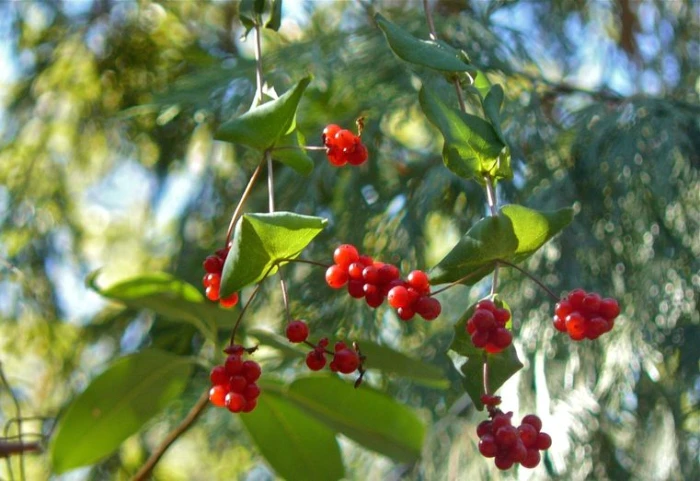Chaparral Honeysuckle
(Lonicera interrupta)
Chaparral Honeysuckle (Lonicera interrupta)
/
/

Jean Pawek
CC BY 3.0
Image By:
Jean Pawek
Recorded By:
Copyright:
CC BY 3.0
Copyright Notice:
Photo by: Jean Pawek | License Type: CC BY 3.0 | License URL: http://creativecommons.org/licenses/by/3.0/ | Attribution: 2013 Jean Pawek | Publisher: Calphotos |




























Estimated Native Range
Climate Requirements for Morgantown, West Virginia
| This Plant | Your Site | Plant Suitability for Your Location | ||
|---|---|---|---|---|
| • Precipitation | 11" - 70" | 42" | Aquatic | Aquatic |
| • High Temp. | 69°F - 103°F | 84°F | Your summer temperatures are normal for this plant. | Excellent |
| • Low Temp. | 13°F - 44°F | 21°F | Your winter temperatures are normal for this plant | Excellent |
This plant may not grow well at your location - your precipitation is too high.
Summary
Lonicera interrupta, commonly known as Chaparral Honeysuckle, is a deciduous perennial vine or shrub native to the chaparral and mixed evergreen forests of California and Baja California. It typically grows to a height of 3-6 feet (0.9-1.8 meters) and spreads to a similar width. The plant features a woody trunk and a sprawling habit, with branches that can either climb or spread across the ground. Chaparral Honeysuckle produces cream to yellow flowers from late spring to early summer, which are tubular in shape and about a centimeter long, with rolled-back lips and prominent stamens that are highly attractive to hummingbirds. The flowers are followed by bright red, spherical berries.
Chaparral Honeysuckle is valued for its drought tolerance and ability to attract wildlife, particularly hummingbirds. It is used in native plant gardens, as a ground cover in dry areas, and for habitat restoration projects. This plant thrives with minimal water once established and prefers well-drained soils, tolerating a range of light conditions from full sun to full shade. While generally low-maintenance, it can be susceptible to aphids and powdery mildew. It is not known to be invasive and does not have aggressive roots, making it a good choice for gardeners looking for a non-intrusive native species.CC BY-SA 4.0
Chaparral Honeysuckle is valued for its drought tolerance and ability to attract wildlife, particularly hummingbirds. It is used in native plant gardens, as a ground cover in dry areas, and for habitat restoration projects. This plant thrives with minimal water once established and prefers well-drained soils, tolerating a range of light conditions from full sun to full shade. While generally low-maintenance, it can be susceptible to aphids and powdery mildew. It is not known to be invasive and does not have aggressive roots, making it a good choice for gardeners looking for a non-intrusive native species.CC BY-SA 4.0
Plant Description
- Plant Type: Vine, Shrub
- Height: 2-6 feet
- Width: 2-3 feet
- Growth Rate: Moderate
- Flower Color: Cream
- Flowering Season: Spring, Summer
- Leaf Retention: Deciduous
Growth Requirements
- Sun: Full Sun, Part Shade, Full Shade
- Water: Low
- Drainage: Medium, Fast
Common Uses
Bee Garden, Bird Garden, Butterfly Garden, Deer Resistant, Drought Tolerant, Fragrant, Hummingbird Garden, Low Maintenance
Natural Habitat
Chaparral and mixed evergreen forests of California and Baja California
Other Names
Common Names:
Scientific Names: Lonicera interrupta, Caprifolium interruptum, Lonicera hispidula var. interrupta
GBIF Accepted Name: Lonicera interrupta Benth.